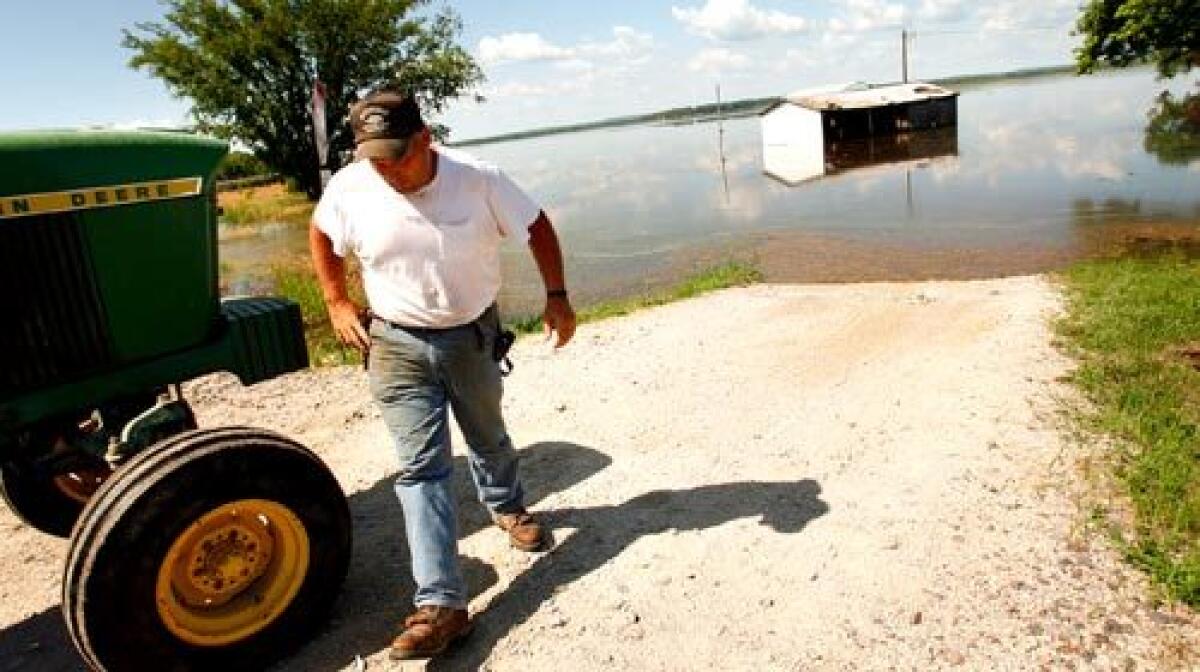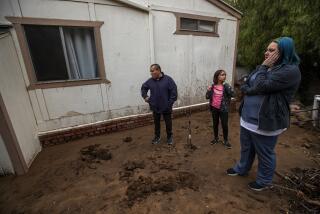Midwest floods’ economic fallout uncertain

. -- Frayed optimism is the best that flood-weary Midwest residents can cling to after a harrowing month of battering rainstorms and swollen rivers that overtopped sodden levees in Iowa and then in Illinois and Missouri.
The signs of economic fallout seem evident from the stark televised images: thousands of acres of fields submerged, towns isolated by muddy moats, barges and trains stalled, families left homeless.
But the contours of the flood’s dislocation are still uncertain, economists and agriculture experts say, and might well be mitigated if the region is spared more high water in the critical coming weeks. A month of dry, balmy weather could spell the difference between a limited disaster and the kind of full-scale crisis that gripped the upper Mississippi River basin for months after the historic floods of 1993.
“The economy’s a lot more flexible than we give it credit for,” said Richard Mattoon, a senior economist with the Federal Reserve Bank in Chicago. “The tough question is how much the flood will change the picture for the Midwest and the national economy -- or will it only reinforce trends that were already going on?”
How deep the misery goes, how long it lasts and how far it spreads to the nation and the world beyond depends on time, weather and a global economy already under stress.
When farmers crowded into their regular tables at Rachel’s Restaurant on Friday morning in the Mississippi River town of Elsberry, they shared the few silver linings they could muster -- and commiserated over the grim tidings that seemed to be spreading as inexorably as the river.
After already having lost half of his 1,600 acres of corn and beans to the Mississippi, Steve Gray still held out hope that he will get by. “I’ll make it some way,” he said.
Market analysts have offered up dire warnings of a paralyzed heartland and record crop prices that could set off inflationary spirals throughout the national and world economy. On Thursday, the Rural Mainstreet Index, a monthly survey of more than 200 bank executives in 10 Midwest states, found that more than 41% said they expected the recent floods to “have a significant impact” on America’s heartland economy.
Rising corn prices, which spiked to a record high of just under $8 a bushel before receding slightly last week, could hike the cost of breakfast cereals, pork chops, ethanol and countless other products. “It’s not just going to have an impact on the national economy, it will have global ramifications,” said Ernest Goss, a professor of regional economics at Creighton University in Omaha who produces the monthly bankers survey.
Yet some experts still hold out hope for positive developments that could counter the damage left by the high water, including successful late-cycle corn and soy plantings if the waters recede quickly enough and the salutary effects elsewhere in the rural Midwest from the same heavy summer rains that caused the Mississippi floods. The Mississippi had shown signs of reaching its crest and even receding near St. Louis, but excess wash from Iowa’s gorged rivers swelled the river Saturday to unexpectedly high flood stages near Canton and Hannibal, Mo.
Even if the national economy staggers later this year from rising food prices, it will not be easy to tell whether the floods were a prime or a marginal factor, stacked up against already dominating causes such as soaring fuel costs and the sinking dollar.
“I don’t know that we have a real good sense at this point between the flood and the other factors,” said Michael D. Boehlje, a professor of agriculture economics at Purdue University. “But when you’re on the edge, any small thing can sometimes have a precipitous impact.”
Boehlje and other agricultural experts point to one crucial difference between the current monthlong flooding and the unrelenting high water that rose on the upper Mississippi for two straight months in July and August 1993. As devastating as the earlier floods were, they were preceded by a then-record corn surplus that kept food prices low and buffered U.S. consumers.
“The damage [in 1993] was easier to ride out in terms of lost farm production,” Mattoon said. “This time the stock is much tighter. Good yields in places that aren’t flooded might help us offset problems at the marketplace. Right now, though, we’re not a good position.”
U.S. agricultural officials had expected the country’s farmers to plant 86 million acres of corn this year, an 8% drop from last year. That tightened supply has contributed to higher bread and meat prices in the U.S. and to spot international shortages that touched off protests and even food riots in Senegal, Haiti and other poor nations. At the same time, corn prices have been driven up by high fuel prices, which raise costs for transporting the corn by truck and barge, and by the plummeting U.S. dollar.
The government’s mandatory standards for ethanol fuel use also appear to have contributed to higher corn prices. Rising demand has touched off a lobbying battle between ethanol backers in the corn industry and grocery and meat processing interests over whether to relax government guidelines on the use of ethanol in gas. At the height of the flooding last week, stock prices for several ethanol producers dropped sharply. VeraSun Energy Corp., the largest U.S. ethanol producer, said it would delay the opening of two Midwest plants because of high corn costs and other market conditions.
On June 30, the Department of Agriculture is to release an updated estimate on 2008 corn yields. Those numbers are expected to be even smaller, probably affected by the flooding and heavy rains.
Missouri farmer Bob Burkemper, 64, lost his crops to the unusually wet spring weather even before the flooding started. Burkemper, who drove to Rachel’s Restaurant from his home in nearby Annada, said the deluge had kept him from carrying out his April and May plantings over 600 acres.
He said he would put his corn and beans in the ground soon, but expected a 15% reduction in yield because of the late start.
His nephew, Andy Burkemper, 31, is in worse shape: At least 1,300 of his 1,400 acres were under water, and he figures to lose as much as $750,000 in projected revenue this year.
“I’m gonna have to do a lot of work with my banker,” he said.
The Mississippi’s rise to record, 500-year flood stages 15 years ago punished the upper Midwest with flooding that left more than $21 billion in damage and chased thousands of residents from their homes.
Some towns withered; others, like Valmeyer, Ill., moved to high ground. But the influx of federal recovery money and private capital that followed created what Mattoon said was an “accelerated boomlet of economic recovery” that lasted for a few years in some communities.
For some 1993 flood victims, however, this month’s high water caused fresh financial injury to old wounds that had never quite healed.
In Keithsburg, Ill., where the Mississippi crested at a record flood stage last week and inundated the town, Harold Felio Jr., 54, a retired welder and artist, lost his house and possessions for the second time.
Felio has spent the years since the 1993 flood building a new place to live 10 feet above ground, on top of his new garage. After his first home was destroyed, Felio lived in a trailer provided by the Federal Emergency Management Agency. Eventually he moved into the garage, where he crammed all of his belongings and looked forward to the day he could move into his new place.
But Wednesday, the Mississippi taunted him again. The flood waters poured in, ravaging all but a handful of clothes and some artwork.
It was hard enough recovering in 1993, when the economy was still strong, he said.
This time around, Felio worries that government aid simply will not cover as much as it did.
“Gas costs more,” he said, “Food costs more. Just living costs more.”
Fausset reported from Elsberry, Huffstutter from Keithsburg and Braun from Washington.
More to Read
Start your day right
Sign up for Essential California for news, features and recommendations from the L.A. Times and beyond in your inbox six days a week.
You may occasionally receive promotional content from the Los Angeles Times.






